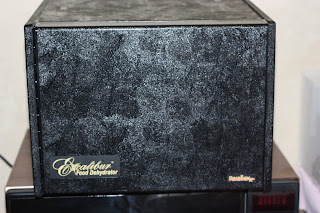To dehydrate fresh potatoes:
- Wash potatoes.
- Boil potatoes until done. You don't want them so done that they fall apart, but they do need to be cooked all the way through. If not, they will turn black when they are dehydrated. Gross.
- Put cooked potatoes in fridge overnight, so they are very cold, and solid.
- If you want, you can peel them. I don't.
- Using either a meat slicer or a cheese grater, either slice the potatoes or grate them. The slices need to be pretty uniform so they will dry evenly.
- Put slices or shreds on trays, in a single layer.
- Dehydrate slices for 10-12 hours or until they are crispy and translucent. If your dehydrator has a temperature control, it should be between 120-125 degrees. This will prevent case hardening (where the outside is dry, but there is still moisture on the inside).
- Dehydrated shreds for 7-9 hours or until they are crispy.
- Best to store in a vacuum packed bag with an oxygen absorber. I like to leave them in a open ziplok bag, then in a vacuum bag. They are pretty sharp, and I don't want them to poke through the vacuum bag.
- These are EXCELLENT for AuGratin Potatoes, casseroles, etc.
- Choose potatoes that do not have added fat to them.
- Put frozen shreds on a single layer on dehydrator trays.
- Dehydrate for 7-9 hours or until crispy. If your dehydrator has a temp. control, set it between 120-125 degrees.
- Best to store in a vacuum packed bag with an oxygen absorber. I like to leave them in a open ziplok bag, then in a vacuum bag. They are pretty sharp, and I don't want them to poke through the vacuum bag.
- These are wonderful rehydrated and fried, or in soups, casseroles, "funeral potatoes" etc.
Frozen potatoes, on sale, for a great price. I love to dehydrate this type because all the work is done for you! It sure makes it easy.
Spread out in a single layer. I like to rotate my trays about 1/2 way through.






so what excalibur food dehydrator do you have? how do you like it? thanks!
ReplyDeleteI have the Excalibur 3926 with a timer. How do I like it? I LOVE IT! Is it worth the money? YES!! I like that I can fit way more food on the trays than with the traditional round type. Also, I love that the fan is at the back, and not on the bottom. Even though it claims to dry the food evenly, the trays really still need to be rotated. The top dries a little slower, as well as the front of the trays. Even with the minor faults, I highly recommend it! The timer is nice, and I have used it quite a lot. However, with some planning, you wouldn't really need that. I may even get another one... when I am dehydrating, I want to do it in mass!
ReplyDeletethanks! love your blog.
ReplyDeleteWhat is the shelf life of dehydrated potates? I want to pack them in canning jars with gasketed lids and store for a few years.
ReplyDeleteStoring any dehydrated food in a canning jar (with an oxygen absorber) is great for short term storage (less than one year) but not ideal for longer term storage. The best way is to vacuum pack (with an oxy absorber) in a vacuum bag and then stored either in Mylar bags or 5 gallon buckets. Make sure they are stored in a dark, cool place for the longest shelf life. Just make sure there is NO oxygen in the packages they are stored in :). I keep the deydrated foods that I am using in a jar, but I don't store them that way long term.
ReplyDeleteWhat is considered long term katie? I have mylar bags and oxygen absorbers.
ReplyDeleteIf stored properly (no moisture left in food, no oxygen in packet etc) dehydrated foods should stay good for 20+ years.
ReplyDeleteI don't have any oxygen absorbers but I have a vacuum attachment for my mason jars and I have a foodsaver for vacuuming in a bag and I have Mylar bags. If dried properly, now long would they last in both the vacuumed mason jar (in cool/dark) and in the foodsaver vacuumed bag and put inside of a mylar bag? I've had white rice that I vacuumed inside of a mylar bags two years ago and have been exposed to some high degrees (80-90) both years. I opened one up yesterday and dumped it in a plate, it appears fine, no visible bugs. I'm hoping this method was okay since I have several of them packaged the same way.
ReplyDeleteHave you tried dehydrating mashed potatoes? I'm posibbly thinking of doing that for use as "instant potatoes" (you know like those fake potatoes on the shelves at the store). I didn't have as great of luck with cubed potatoes. When I rehydrated them they had a very odd consistency.
ReplyDeleteI have never tried doing mashed potatoes! Let us know how it goes. I like using the dehyrated cubed potatoes for soup- it works quite well! Good luck!
ReplyDelete